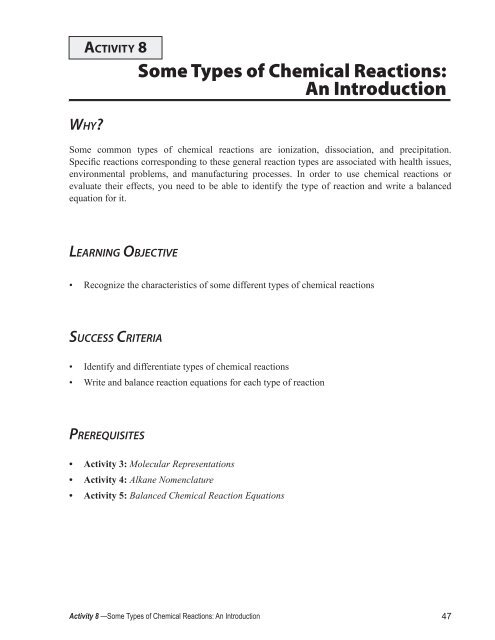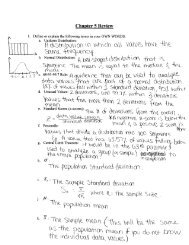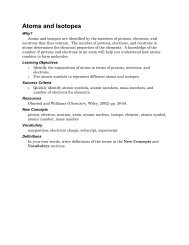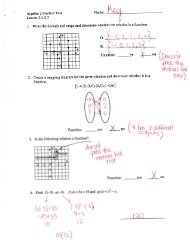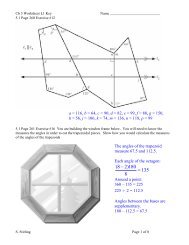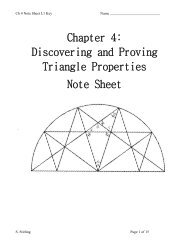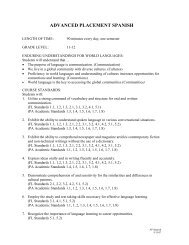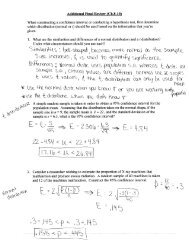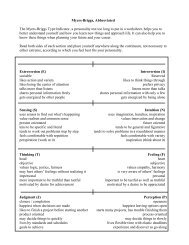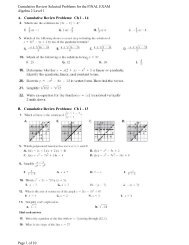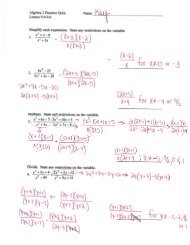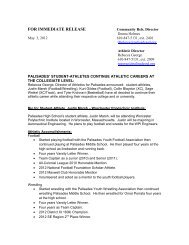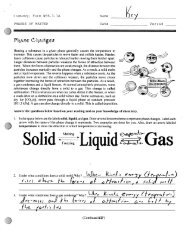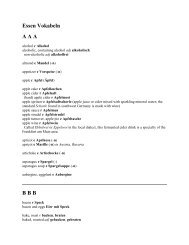Some Types of Chemical Reactions: An Introduction
Some Types of Chemical Reactions: An Introduction
Some Types of Chemical Reactions: An Introduction
Create successful ePaper yourself
Turn your PDF publications into a flip-book with our unique Google optimized e-Paper software.
Activity 8<br />
<strong>Some</strong> <strong>Types</strong> <strong>of</strong> <strong>Chemical</strong> <strong>Reactions</strong>:<br />
<strong>An</strong> <strong>Introduction</strong><br />
Why?<br />
<strong>Some</strong> common types <strong>of</strong> chemical reactions are ionization, dissociation, and precipitation.<br />
Specific reactions corresponding to these general reaction types are associated with health issues,<br />
environmental problems, and manufacturing processes. In order to use chemical reactions or<br />
evaluate their effects, you need to be able to identify the type <strong>of</strong> reaction and write a balanced<br />
equation for it.<br />
Learning Objective<br />
• Recognize the characteristics <strong>of</strong> some different types <strong>of</strong> chemical reactions<br />
Success Criteria<br />
• Identify and differentiate types <strong>of</strong> chemical reactions<br />
• Write and balance reaction equations for each type <strong>of</strong> reaction<br />
Prerequisites<br />
• Activity 3: Molecular Representations<br />
• Activity 4: Alkane Nomenclature<br />
• Activity 5: Balanced <strong>Chemical</strong> Reaction Equations<br />
Activity 8 —<strong>Some</strong> <strong>Types</strong> <strong>of</strong> <strong>Chemical</strong> <strong>Reactions</strong>: <strong>An</strong> <strong>Introduction</strong> 47
Model:<br />
<strong>Types</strong> <strong>of</strong> <strong>Reactions</strong><br />
Table 8.1<br />
Reaction Type / Characteristic<br />
Ionization in water<br />
substance reacts with water to produce ions<br />
HCl(g) + H 2 O(l)<br />
NH 3 (aq) + H 2 O(l)<br />
Example<br />
H 3 O + (aq) + Cl – (aq)<br />
NH 4 + (aq) + OH – (aq)<br />
Dissociation in water<br />
substance dissociates in water to produce<br />
ions<br />
NaCl(s)<br />
Co(NO 3 ) 2 (s)<br />
Na + (aq) + Cl – (aq)<br />
Co 2+ (aq) + 2NO 3 – (aq)<br />
Neutralization<br />
an acid and a base react to produce water<br />
and a salt<br />
Precipitation in water<br />
a solid forms from ions in aqueous solution<br />
Substitution reaction<br />
one chemical species displaces another<br />
Addition reaction<br />
a chemical species adds to a double bond<br />
Elimination reaction<br />
a proton is removed, an ion leaves, and a<br />
double bond is formed<br />
KOH(s) + HNO 3 (aq) H 2 O + KNO 3 (aq)<br />
Ag + (aq) + Cl – (aq) AgCl(s)<br />
CH 3 CH 2 Br + CN – CH 3 CH 2 CN + Br –<br />
CH 2 =CH 2 + Br 2 CH 2 Br-CH 2 Br<br />
CH 2 Br-CH 3 + OH – CH 2 =CH 2 + H 2 O + Br –<br />
aq = aqueous, g = gas, s = solid, l = liquid<br />
Key Questions<br />
1. What are the characteristics <strong>of</strong> the reactions that are described in the model that you can use to<br />
identify the reaction? (You need to remember these characteristics; writing them will help you<br />
remember.)<br />
a) ionization<br />
The substance reacts with water to form ions.<br />
b) dissociation<br />
The substance dissociates in water to form ions.<br />
c) neutralization<br />
<strong>An</strong> acid and a base react to produce water and a salt.<br />
48<br />
Foundations <strong>of</strong> Chemistry
d) precipitation<br />
Ions in aqueous solution react to form a solid.<br />
e) substitution<br />
One chemical species displaces another.<br />
f) addition<br />
A chemical species adds to a double bond.<br />
g) elimination<br />
A proton is removed, an ion is eliminated, and a double bond is formed.<br />
Exercises<br />
1. Balance the following reactions and identify the reaction type.<br />
Ca(NO 3 ) 2 (s)<br />
Ca 2+ (aq) + NO 3<br />
– (aq)<br />
Ca(NO 3 ) 2 (s) Ca 2+ (aq) + 2 NO 3<br />
- (aq) dissociation<br />
H 2 PO 4 – (aq) + H 2 O(l)<br />
HPO 4 2– (aq) + H 3 O + (aq)<br />
Balanced<br />
ionization<br />
Al 3+ (aq) + OH – (aq)<br />
Al(OH) 3 (s)<br />
Al 3+ (aq) + 3 OH - (aq) Al(OH) 3 (s) precipitation<br />
NaOH(s) + HCl(aq)<br />
H 2 O(l) + NaCl(aq)<br />
Balanced<br />
neutralization<br />
2. Write two ionization reactions that occur when carbonic acid H 2 CO 3 , a diprotic acid, is added<br />
to water. Diprotic means that two protons are acidic and can react with water and ionize.<br />
H 2 CO 3 (aq) + H 2 O(l)<br />
HCO 3 - (aq) + H 3 O + (aq)<br />
HCO 3 - (aq) + H 2 O(l)<br />
CO 3 2- (aq) + H 3 O + (aq)<br />
Activity 8 —<strong>Some</strong> <strong>Types</strong> <strong>of</strong> <strong>Chemical</strong> <strong>Reactions</strong>: <strong>An</strong> <strong>Introduction</strong> 49
3. For the reaction between calcium nitrate and sodium sulfate in aqueous solution:<br />
a) Write the dissociation reaction equations for calcium nitrate and sodium sulfate when they<br />
dissolve in water.<br />
Ca(NO 3 ) 2 (s)<br />
Ca 2+ (aq) + 2 NO 3 - (aq)<br />
Na 2 SO 4 (s)<br />
2 Na + (aq) + SO 4 2- (aq)<br />
b) Using only the ions that are actually involved, write the precipitation reaction that forms<br />
CaSO 4 (s).<br />
Ca 2+ (aq) + SO 4 2- (aq)<br />
CaSO 4 (s)<br />
Information<br />
Your answer to Exercise 3(b) is a net ionic equation. Net ionic equation means that only the ions<br />
that react are included. The ions that do not react are omitted from the equation even though they<br />
are present in solution. The ions that do not react are called spectator ions.<br />
4.<br />
Label each <strong>of</strong> the following reactions as substitution, addition, or elimination.<br />
+ HBr<br />
H<br />
Br<br />
addition<br />
H H<br />
Br<br />
I<br />
Br<br />
I<br />
substitution<br />
Br<br />
+ NaOH + H 2 O + NaBr<br />
elimination<br />
50<br />
Foundations <strong>of</strong> Chemistry
Problems<br />
1.<br />
Label each <strong>of</strong> the following reactions as substitution, addition, or elimination. Complete the<br />
reaction equation by filling in the boxes with the missing compounds.<br />
+<br />
HBr<br />
Br<br />
addition<br />
Cl<br />
CN<br />
+ KCN<br />
+<br />
KCl<br />
substitution<br />
2. Sodium methoxide (NaOCH 3 ) dissociates to produce OCH – 3 , which reacts like OH – .<br />
2-Bromopentane<br />
20<br />
and sodium methoxide can react together to form three different elimination<br />
products and one substitution product. Draw these four possible products. Two <strong>of</strong> the elimination<br />
products are isomers.<br />
15<br />
luminescence intensity<br />
SI( x)<br />
SII( x)<br />
SIII( x)<br />
10<br />
Elimination products<br />
trans-2-pentene<br />
Substitution product<br />
O<br />
5<br />
cis-2-pentene<br />
0<br />
75 80 85 90 95 100 105 110 115 120 125<br />
1-pentene<br />
x<br />
wavelength in nm<br />
Activity 8 —<strong>Some</strong> <strong>Types</strong> <strong>of</strong> <strong>Chemical</strong> <strong>Reactions</strong>: <strong>An</strong> <strong>Introduction</strong> 51
3. Identify the type <strong>of</strong> reaction and write the reaction equation for each <strong>of</strong> the following situations.<br />
a) Ammonium chloride, NH 4 Cl, dissolves in water to produce ions.<br />
NH 4 Cl(s) NH 4 + (aq) + Cl - (aq) dissociation<br />
b) A solid forms when sodium hydroxide, NaOH, is added to a solution <strong>of</strong> magnesium nitrate,<br />
Mg(NO 3 ) 2 . Write the net ionic equation for this reaction.<br />
Mg 2+ (aq) + 2OH - (aq) Mg(OH) 2 (s) precipitation<br />
c) Sodium hydroxide, NaOH, reacts with acetic acid, CH 3 COOH. The proton attached to<br />
oxygen is the one that is acidic.<br />
NaOH(aq) + CH 3 COOH(aq) NaCH 3 COO (aq) + H 2 O(l) neutralization<br />
52<br />
Foundations <strong>of</strong> Chemistry


